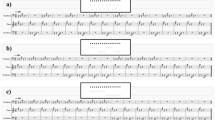Abstract
This article investigated both the ability of naive human subjects to learn interval production, as well as the properties of learning generalization across modalities and interval durations that varied systematically from the over-trained interval. Human subjects trained on a 450-, 650-, or 850-ms single-interval production task, using auditory stimuli to define the intervals, showed a significant decrease in performance variability with intensive training. This learning generalized to the visual modality and to non-trained durations following a Gaussian transfer pattern. However, the learning carryover followed different rules, depending on the duration of the trained interval as follows: (1) the dispersion of the generalization curve increased as a function of the trained interval, (2) the generalization pattern was tilted to the right in the visual condition, and (3) the transfer magnitude for 650 ms was less prominent than for the other two intervals. These findings suggest the existence of neural circuits that are tuned to specific time lengths and that show different temporal processing properties depending on their preferred interval duration.




Similar content being viewed by others
References
Buonomano DV (2000) Decoding temporal information: a model based on short-term synaptic plasticity. J Neurosci 20(3):1129–1141
Buonomano DV, Karmarkar UR (2002) How do we tell time? Neuroscientist 8(1):42–51
Collyer CE, Broadbent HA, Church RM (1992) Categorical time production: evidence for discrete timing in motor control. Percept Psychophys 51(2):134–144
Collyer CE, Broadbent HA, Church RM (1994) Preferred rates of repetitive tapping and categorical time production. Percept Psychophys 55(4):443–453
Fant G, Kruckenberg A (1996) On the quantal nature of speech timing. In: Proceedings of ICSLP 1996, Philadelphia, pp. 2044–2047
Gibbon J, Malapani C, Corby LD, Gallistel CR (1997) Toward a neurobiology of temporal cognition: advances and challenges. Curr Opin Neurobiol 7:170–184
Goldstone S, Lhamon WT (1974) Studies of auditory-visual differences in human time judgement. 1. Sounds are judged longer than lights. Percept Mot Skills 39(1):63–82
Grondin S (2001) From physical time to the first and second moments of psychological time. Psychol Bull 127(1):22–44
Ivry R (1996) The representation of temporal information in perception and motor control. Curr Opin Neurobiol 6:851–857
Ivry RB, Schlerf JE (2008) Dedicated and intrinsic models of time perception. Trends Cogn Sci 12(7):273–280
Karmarkar UR, Buonomano DV (2003) Temporal specificity of perceptual learning in an auditory discrimination task. Learn Mem 10:141–147
Karmarkar UR, Buonomano DV (2007) Timing in the absence of clocks: encoding time in neural network states. Neuron 53:427–438
Kristofferson AB (1980) A quantal step function in duration discrimination. Percept Psychophys 27(4):300–306
Lewis PA, Miall RC (2003) Distinct systems for automatic and cognitively controlled time measurement: evidence from neuroimaging. Curr Opin Neurobiol 13:250–255
Mauk MD, Buonomano DV (2004) The neural basis of temporal processing. Annu Rev Neurosci 27:307–340
Meegan DV, Aslin RN, Jacobs RA (2000) Motor timing learned without motor training. Nat Neurosci 3(9):860–862
Merchant H, Georgopoulos AP (2006) Neurophysiology of perceptual and motor aspects of interception. J Neurophysiol 95:1–13
Merchant H, Zarco W, Prado L (2008a) Do we have a common mechanism for measuring time in the hundreds of milliseconds range? Evidence from multiple-interval timing tasks. J Neurophysiol 99:939–949
Merchant H, Zarco W, Bartolo R, Prado L (2008b) The context of temporal processing is represented in the multidimensional relationships between timing tasks. PLoS ONE 3(9):e3169
Merchant H, Luciana M, Hooper C, Majestic S, Tuite P (2008c) Interval timing and Parkinson’s disease: heterogeneity in temporal performance. Exp Brain Res 184:233–248
Merchant H, Zarco W, Prado L (2008d) Neurophysiology of temporal information processing in the medial premotor areas of the primate. Neuroscience 2008 Annual Meeting. The Society for Neuroscience. Abstract number: 877.3
Merchant H, Zarco W, Prado L, Perez O (2009) Behavioral and neurophysiological aspects of target interception. Adv Exp Med Biol 629:201–220
Moelants D (2002) Preferred tempo reconsidered. In: Stevens C, Burnham D, McPherson G, Schubert E, Renwick J (eds) Proceedings of the 7th international conference on music perception and cognition. AMPS—Causal Productions, Sydney, pp. 580–583
Nagarajan SS, Blake DT, Wright BA, Byl N, Merzenich M (1998) Practice related improvements in somatosensory interval discrimination are temporally specific but generalize across skin location, hemisphere, and modality. J Neurosci 18(4):1559–1570
Schoups A, Vogels R, Qian N, Orban G (2001) Practising orientation identification improves orientation coding in V1 neurons. Nature 412:549–553
Snedecor GW, Cochran WG (1989) Statistical methods. Iowa State University Press, Ames, IA
Treisman M, Faulkner A, Naish PLN (1992) On the relation between time perception and motor action: evidence for a temporal oscillator controlling the timing of movement. Q J Exp Psychol 45A(2):235–263
Wearden JH, Edwards H, Fakhri M, Percival A (1998) Why “sounds are judged longer than lights”: application of a model of the internal clock in humans. Q J Exp Psychol 51B(2):97–120
Westheimer G (1999) Discrimination of short time intervals by the human observer. Exp Brain Res 129:121–126
Wright BA, Buonomano DV, Mahncke HW, Merzenich MM (1997) Learning and generalization of auditory temporal-interval discrimination in humans. J Neurosci 17(10):3956–3963
Acknowledgments
We are grateful to Dean Buonomano, Roberto Prado, and Dagmar Sternad for their fruitful comments on the manuscript. We also thank Dorothy Pless for proofreading the paper and Luis Prado and Raúl Paulín for their technical assistance. Supported in part by PAPIIT: IN206508-19, FIRCA: TW007224-01A1, and CONACYT grant 47170.
Author information
Authors and Affiliations
Corresponding author
Electronic supplementary material
Below is the link to the electronic supplementary material.
Rights and permissions
About this article
Cite this article
Bartolo, R., Merchant, H. Learning and generalization of time production in humans: rules of transfer across modalities and interval durations. Exp Brain Res 197, 91–100 (2009). https://doi.org/10.1007/s00221-009-1895-1
Received:
Accepted:
Published:
Issue Date:
DOI: https://doi.org/10.1007/s00221-009-1895-1




